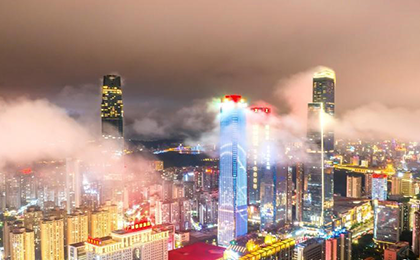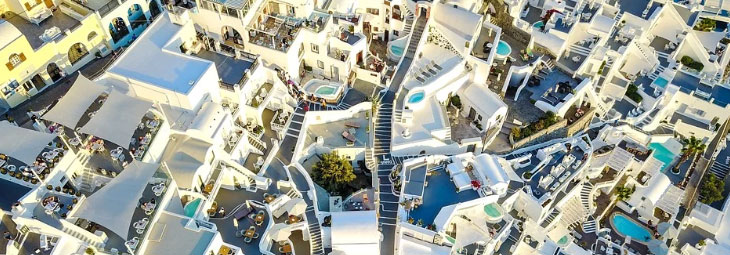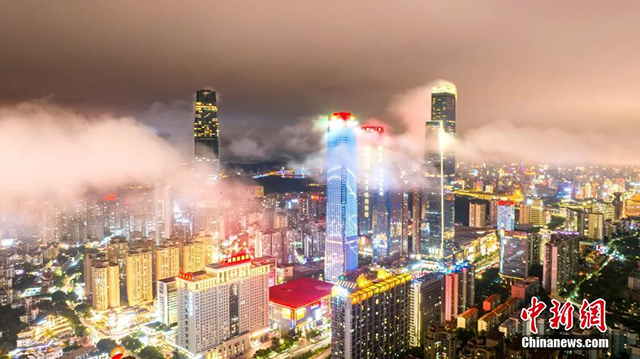



▲ A night view of Nanning city covered by clouds and fog. [Chinanews.com]
5. Planning Contents.
5.1 Safe and sustainable, optimizing the overall layout of “Three Zones and Three Lines”.
(1) Coordinating the delineation of “Three Zones and Three Lines”.
Prioritize the delineation of farmland and farmland and permanent basic cropland red lines. Ensure cropland retention of no less than 7.0705 million mu and permanent basic cropland covering no less than 6.0225 million mu. Scientifically delineate the ecological protection red line spanning 3,020.52 square kilometers. Reasonably delineate urban development boundaries of an area of 905.57 square kilometers.
(2) Establishing an overall framework of “One Screen, Four Zones, One Belt, and One Area” for the development and protection of territory.
“One Screen” refers to the northern ecological shield, a critical component of the ecological barrier in western and northern Guangxi. This area focuses on water conservation and biodiversity maintenance.
“Four Zones” refers to four agricultural development zones, including the Wuming-Long’an Agricultural Development Zone, Binyang-Shanglin Agricultural Development Zone, Hengzhou Agricultural Development Zone, and the Southern Agricultural Development Zone. These zones form Nanning’s primary grain production areas and are integral parts of the Xunyu Plain’s agricultural production area.
“One Belt” refers to the Yongjiang River protection and development belt, which links towns and ecological nodes, including Long’an County, Sanjiangkou, the central urban area, the eastern new town, Xijin Wetlands, Hengzhou City, etc. This comprehensive belt not only ensures the connectivity of the Zuojiang-Youjiang green corridor but also supports the Pearl River-Xijiang Economic Belt and connections to the Guangdong-Hong Kong-Macao Greater Bay Area.
“One Area” refers to the metropolitan area of Nanning, encompassing the central urban area, Wuming sub-city, the eastern new town, and the airport economic demonstration zone. This area is not only the core area to drive urban development, optimize the urban system, and cultivate the Nanning metropolitan circle, but also serves as the core engine in Guangxi and Beibu Gulf City Cluster.
(3) Securing room for agricultural production.
Optimize six key agricultural production zones: the "grain supplies" grain production zones, urban food supply zones, special high-efficiency agricultural demonstration zones, ecological farming demonstration zones in karst regions, urban leisure agriculture demonstration zones, and selenium-rich agricultural zones.
(4) Prioritizing ecology and establishing a systematic ecological security framework.
Construct an ecological security framework consisting of "One Shield, One Belt, Two Zones, And Ten Corridors", reinforcing the ecological barrier in western and northern Guangxi.
“One Shield” refers to the northern ecological shield.
“One Belt” refers to the Yongjiang River ecological protection belt.
“Two Zones” refers to the ecological function zones of Nanning Dawangtan National Wetland Park and the Hengxian Xijin National Wetland Park.
“Ten Corridors” refers to six river ecological corridors and four forest ecological corridors.
(5) Integrating and optimizing of nature reserves.
By 2035, establish a clearly defined, well-regulated, and effectively supervised system of nature reserves. Under a conservation-first principle, ensure the resources within these reserves are shared equitably by all.
(6) Promoting the holistic conservation and systematic management of mountain, water, forest, lake, farmland, grassland, and desert ecosystems.
Adopt a region-wide approach to coordinate the conservation and restoration of nine key restoration zones to create a linked ecological conservation and restoration framework of “mountains + wetlands + watersheds”, reinforcing the ecological barrier in western and northern Guangxi. Implement six types of restoration projects based on geographically cohesive natural units.
(7) Forming an urban spatial structure with “One Core, Three Sub-City Centers, and Multiple Nodes”.
“One Core” refers to the central urban area of Nanning, serving as the primary hub for political, economic, cultural, and international exchanges, as well as the core carrier of Guangxi's capital city functions. It is the driving force for optimizing urban development across the region.
“Three Sub-City Centers” refers to the Wuming sub-city center, Eastern New Town, and Airport Economic Demonstration Zone. Specifically, the Wuming sub-city center focuses on enhancing comprehensive urban functions, the Eastern New Town accelerates the growth of a new economic hub, and the Airport Economic Demonstration Zone leverages its role as a cross-border open platform, strengthens connectivity and functional synergy with the central urban area, and promotes integrated industrial-urban development. These sub-city centers are critical for upgrading the city's development capacity and regional influence.
“Multiple Nodes” refers to the six regional central towns including Long’an County, Mashan County, Shanglin County, Binyang County, Hengzhou City, and Litang Town as well as other key towns such as Wutang Town, Jinling Town, Nama Town, Datang Town, Natong Town, and Xiaoyi Town. These nodes serve as essential carriers for balanced urbanization within the city.
(8) Safety and resilience, enhancing urban risk resistance.
Establish a modern, efficient, intelligent, green, and reliable infrastructure system. Coordinate the planning and development of urban infrastructure, including water supply, wastewater treatment, power, energy, waste management, and communications, to enhance the city's operational safety and reliability.
Delineate flood risk control boundaries, strengthen public health, fire safety, and civil defense infrastructure, and optimize the spatial layout of industries dealing with hazardous chemicals. Reserve space for dual-use public infrastructure (for both peacetime and emergencies) to ensure the stability of the city's critical lifeline systems.
Source:<https://mp.weixin.qq.com/s/pIvve09Ct3OLzU2iJOcjDQ>
Editor & Translator: GUO Xinxin